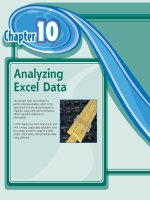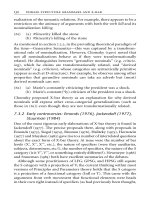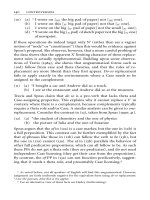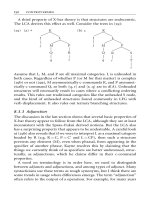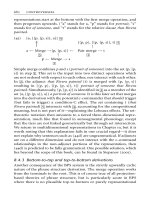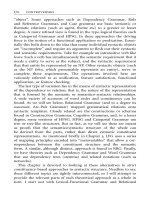Tài liệu Constituent Structure - Part 19 pptx
Bạn đang xem bản rút gọn của tài liệu. Xem và tải ngay bản đầy đủ của tài liệu tại đây (106.3 KB, 10 trang )
representations start at the bottom with the Wrst merge operation, and
then progresses upwards. (‘‘a’’ stands for a, ‘‘p’’ stands for portrait,‘‘s’’
stands for of someone, and ‘‘t’’ stands for the relative clause that Rivera
painted.
(45) {a, {{p, {p, s}}, a}}
4
"
{hp, pi, {{p, {p, s}}, t} 5
"
a Merge !{p, {p, s}} Pair merge ! t
3 " 2
p Merge ! s
1
Simple merge combines p and s (portrait of someone) into the set {p, {p,
s}} in step
1 . This set is the input into two distinct operations which
are not ordered with respect to each other, nor interact with each other.
In
2 , the adjunct that Rivera painted (t) is merged with {p, {p, s}}
resulting in {hp, pi, {{p, {p, s}}, t}} portrait of someone that Rivera
painted. Simultaneously, {p, {p, s}} is identiWed in
3 as a member of the
set {a, {{p {p, s}}, a}} a portrait of someone. It is this later set that merges
into the derivation with the potential c-commander that should trigger
(but fails to trigger) a condition-C eVect. The set containing t (that
Rivera painted)
5 intersects with 4 , accounting for the compositional
meaning, but is not part of it—explaining the Lebeaux eVects. The set-
theoretic notation then amounts to a tiered three-dimensional repre-
sentation, much like that found in autosegmental phonology, except
that the tiers are not linked geometrically but through set intersection.
We return to multidimensional representations in Chapter 10, but it is
worth noting that this explanation fails in one crucial regard—it does
not explain why sentences such as (44d) are ungrammatical. If adjuncts
are on a diVerent dimension and do not interact with the c-command
relationships in the non-adjunct portions of the representation, then
(44d) is predicted to be fully grammatical. One possible solution, which
lies beyond the scope of this book, can be found in Stepanov (2001).
8.4.3 Bottom-to-top and top-to-bottom derivations
Another consequence of the BPS system is the strictly upwardly cyclic
nature of the phrase structure derivation. The merge operation works
from the terminals to the root. This is of course true of all projection-
based theories of phrase structure, but is particularly acute in BPS
where there is no plausible top-to-bottom or purely representational
160 controversies
equivalent. This is even more the case in the latest ‘‘phase-theoretic’’
versions of BPS, where the bottom-to-top derivation is crucial to the
mechanics of the Move operation.
8.4.3.1 Bottom-to-top derivations It has long been observed that
both syntactic and syntactico-phonological operations are frequently
limited in their scope by the hierarchical structure of the sentence (see
for example the notion of a ‘‘kernal sentence’’ found in Chomsky 1955,
1957; and the notion of cycle found throughout the 1960s and 1970s,
Fillmore 1963; the notion of Government Domain in the 1980s; the
notion of minimality in the 1990; and phases in the 2000s). In
particular, various phenomena from stress placement to binding
theory to displacement operations seem to function as if they work
on the smallest, most embedded structure outwards to the largest least
embedded structure. If BPS is a strictly bottom-to-top model, we can
see syntactic cycles as a natural consequence of the derivation
procedure. This was Wrst pointed out by Epstein (1999) and Epstein
et al.(1998), who argue that all locality constraints, especially those
based on c-command relationships, follow from this basic
organizational principle (as you will recall from our discussion in
Ch. 3, section 3.5.4).22
8.4.3.2 Top-to-bottom derivations A consequence of bottom-to-top
derivations—especially ones that are subject to the LCA—is that they
are also typically right to left (or more saliently, from the end of the
sentence to the beginning). There is something singularly counter-
intuitive about this, especially since sentences are obviously spoken
(and processed) from the beginning to the end. We might use the old
competence–performance distinction to get out of this, but it still feels
like a cop-out in the end.
Phillips (2003) presents some evidence that a top-to-bottom tree
derivation23 elegantly explains why some constituency tests appear to
22 Uriagereka (1999) converges on a similar view, but suggests further that units formed
by merge (command units) are spelled out cyclically. This in turn leads to the Chomskyan
Phase Theory (Chomsky 2001) and the Minimalist/Tree Adjoining Grammar fusion of
Frank (2002). Interestingly, Uriagereka’s command unit hypothesis also explains why
structures like [
A
[
B
DE][
C
F G]] are not violations of the LCA, since B and C would be
independently spelled out.
23 Richards (1999) has also argued for a top-to-bottom derivation using data from
island eVects (and the occasional lack thereof). Baltin (2006) provides an alternative
analysis of some of Phillips facts using VP-remnant movement.
set-theoretic constituency 161
be contradictory. Consider the following sentences taken from Phillips,
which show straightforward evidence for a rightward-branching struc-
ture. Coordination (46a), ellipsis/replacement (46b), movement (46c),
binding/c-command (46d, e) all seem to point to a Verb þ Object
constituent (all examples taken from Phillips).
(46) (a) Gromit [likes cheese] and [hates cats]. VO constituent
(b) Gromit [likes cheese] and
Wallace does too.
VO constituent
(c) [Like cheese] though Gromit does t, he
can not stand Brie.
VO
(d) Wallace and Gromit like each other.
(e) *Each other like Wallace and Gromit.
But when we look at more complex constructions like ditransitve
verbs, the results seem mixed. We see behaviors where strings that we
normally identify as non-constituents obey some constituency tests
(47a–c), but the same strings do not obey others (47d–e).
(47) (a) Wallace gave [Gromit a biscuit] and [Shawn some cheese]
for breakfast.
(b) [Wallace designed] and [Gromit built] an enormous tin
moon rocket. (SV)
(c) Alice [knew that Fred wanted to talk] and [hoped that he
wanted to argue] with the president.
(d) *[Gromit a biscuit] Wallace gave t for Breakfast.
(e) *Wallace gave t at breakfast [his favorite pet beagle an enor-
mous chewy dog biscuit].
Phillips claims that an explanation for these kinds of phenomenon
follow if we build trees incrementally from left to right (and conse-
quently in a right-branching language, top to bottom.) The basic rule
of tree construction is given in (48).
()X X
ABAY
BC
The behaviors seen in (47) follow if constituency tests apply to
those strings that are constituents at the point in the incremental
derivation the phenomenon is exhibited. This can be seen in the various
162 controversies
applications of coordination at various left to right portions in the
following sentences.
(49) (a) [Wallace will]
[Wallace will] and [Wedonlene probably won’t]
[Wallace will] and [Wedonlene probably won’t] give Grom-
mit crackers.
(b) [Wallace will give]
[Wallace will give] and [Wendolene will send]
[Wallace will give] and [Wendolene will send] some crackers.
(c) [Wallace will give Gromit]
[Wallace will give Gromit] and [Wendolene will give
Preston]
[Wallace will give Gromit] and [Wendolene will give
Preston] a new collar.
(d) [Wallace will give Gromit crackers]
[Wallace will give Gromit crackers] and [Wendoline will
give Preston dog food]
[Wallace will give Gromit crackers] and [Wendoline will
give Preston dog food] before breakfast.
(e) [Wallace will give Gromit crackers before]
[Wallace will give Gromit crackers before] and [Wendoline
will give Preston dog food after]
[Wallace will give Gromit crackers before] and [Wendoline
will give Preston dog food after] breakfast.
8.4.4 Derived X-bar theory
The particular version of derived X-bar theory found in BPS has some
interesting empirical and theoretical consequences. Consider the case
of a head that does not project. Such an element is simultaneously an
X8 and an XP (as it is dominated by the projection of another cat-
egory). Interestingly, such animals appear to exist. Clitics have the
behavior of elements that are simultaneously X8s and XPs. They are
theta-marked and allow violations of the head-movement constraint,
yet they adjoin to other X8s; such behavior is expected of elements that
are ambiguous in their phrasality.
Chomsky limits the range of such ambiguity by proposing that
morphology (or its LF analog ‘‘word interpretation’’) gives no output
to an element that has complex internal structure (cf. Nun
˜
es 1998). So
set-theoretic constituency 163
we expect to Wnd cases like the clitic case above, where a simplex
element is simultaneously an XP and an X8, but complex elements
are not allowed in this position.
In Carnie (1995) and (2000), I argue that a more liberal deWnition of
phrasality is in order. In particular, I suggest that the phrasal status of a
constituent is not determined by its position in the projection struc-
ture in the tree. Further, I claim that phrasal status does not predict
outward behavior with respect to interface conditions and constraints
(such as the morphology, thematic relations, case marking, and head-
movement rules). Rather, the syntax can operate freely on any node in
the tree, applying operations as needed. The output conditions, in
particular the morphology, then determine what nodes are to be
spelled out as words and which are to be spelled out as phrases. The
cases that show this to be true are those where we have either an
apparently X8 functioning like a phrase (as in the clitic case mentioned
above) or more interestingly, an apparent XP functioning like an X8.
We can identify such cases with the following criteria: if a particular
p-marker behaves diVerently in terms of its phrasality with respect to
two diVerent output conditions or two diVerent components of the
grammar, then it must be the case that its phrasality is not determining
its behavior, but rather the behavior determines the phrasality relative
to the particular output condition or component of the grammar.
The Wrst case I consider are copular constructions in Irish. Irish is a
VSO language, and I assume that this order is derived via movement
of the V around the subject into some functional head via head
movement. There is a privileged position occupied by predicates
in the language, which is between sentence initial complementizer
particles and agreement (Particle < Predicate < Agreement < Subject
<...). Following standard practice (Sproat 1985 and many others),
I identify this position as being derived through head movement. In
predicative copular constructions (ºx[NP’(x)]) and nominal and other
non-verbal predicates appear in this position (a), even when they are
phrasal (b):
(50) (a) Is ollamh (e
´
) Aindriu
´
.
C professor (agr) Andrew
‘‘Andrew is a professor.’’
(b) Is amhra
´
na
l
bhuailWdh an pı
´
obaire ‘‘Yellow Submarine.’’
C song C play.fut the piper
‘‘‘Yellow Submarine’ is a song which the piper is going to play.’’
164 controversies


